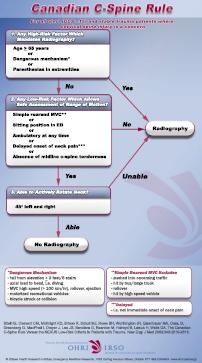
Key words: Canadian C-Spine Rule, NEXUS C-Spine, neck injury, neck CT, clinical decision guidelines, clinical decision rules. Future projects can focus on the utilization of other clinical guidelines for the management of low-risk patient populations. One study directly compared the accuracy of these 2 rules using the same cohort and found that the Canadian C-spine rule had better accuracy. For NEXUS, sensitivity ranged from 0.83 to 1.00 and specificity ranged from 0.02 to 0.46.
#Canadian c spine rules full
To have access to full article that these tools were developed for, please subscribe. For the Canadian C-spine rule, sensitivity ranged from 0.90 to 1.00 and specificity ranged from 0.01 to 0.77. Improving mechanical neck pain starts with educating the patient about the favourable prognosis and increasing the range of neck movement: a cervical collar is contraindicated. The findings suggested significant reduction in unnecessary imaging and identified patients needing ED referral for more advanced imaging. The need for an x-ray should be based on the Canadian C spine rules. The literature supports the use of validated clinical-decision guidelines to improve assessment, minimize costs, foster resource utilization, decrease the length of stay in waiting rooms, and reduce unnecessary radiation exposure. This algorithmic approach to assessment of patients with suspected cervical spine injury is widely used across the world. Encouraging providers to increase patient engagement and to use other valuable diagnostic tests is part of the solution to over imaging. Notable clinical prediction rules to determine which patients need medical imaging are the Canadian C-spine rule and the National Emergency X-Radiography. The use of imaging can help to identify life-threatening neck injuries when clinically appropriate however, unnecessary imaging without the use of a clinical decision tool is associated with an annual cost of $6.8 million-$9.6 million in the United States.

#Canadian c spine rules pdf
The aim of this evidence-based project was to implement the Canadian C-Spine Rule guideline for low-risk c-spine injury in a urban urgent care in order to reduce unnecessary imaging (cervical X-ray), radiation exposure, and to identify patients requiring ED referral for computed tomography (CT) scans. OPTION 1 : Adobe PDF: Available at no cost, download the PDF files to your local printer for professional printing and laminating, or print from home or the office.


 0 kommentar(er)
0 kommentar(er)
